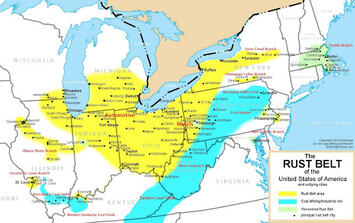
Here’s one representation of the Rust Belt. However, just like with definitions of the Midwest overall, people usually identify where they live in the region as the center of it.
The Rust Belt has been given up for dead, at least economically, for the last 50 years. The broad swath of territory that covers the Northeastern and Midwestern United States, centered on the Great Lakes, has seen decades of economic retrenchment, out-migration, unresolved racial tensions, and a growing sense of irrelevance — especially when compared to America’s globally-connected coastal cities and fast-growing Sun Belt cities. There are some who believe the Rust Belt should simply accept its diminished fate and fade into oblivion.
This perception has been internalized by many of the Rust Belt’s own residents. Those who remember the Rust Belt’s halcyon days are mostly senior citizens now. The region’s teeming factories employing thousands of workers have spread to nations across the globe. Productivity gains and automation have further reduced reliance on a low- and mid-skilled workforce. There’s a prevailing sense that, after experiencing so much loss, for so long, the future must also be bleak. And so people yearn for restoration, a return to what once was.
From that, however, an alternative perspective has emerged. A rising number of today’s Rust Belt residents recognize the potential of the region. They embrace the region’s history but see opportunity in an uncertain future. Rather than focusing on the negatives that defined it for a half-century, more people are touting the region’s assets and potential. This group has refused to accept the fate of a lost region. They have given rise to Rust Belt urbanism.
In his introduction to EIG as the new Legacy Cities Fellow, Akron, OH planner Jason Segedy eloquently described the Rust Belt’s former and current position in the hierarchy of American cities:
“Many cities like Buffalo, Cleveland, Dayton, Detroit, Erie, Flint, Rochester, South Bend, Toledo, and Youngstown have experienced incredible ups and downs over the last 150 years.
These cities were some of the largest and fastest-growing cities in the nation by World War I. But after World War II, these cities began a painful period of economic and social decline, as three national trends – the decline and outsourcing of manufacturing, regional outmigration to the Sunbelt, and rapid suburbanization – converged on these communities.”
The convergence of those trends created the Rust Belt we know today. Yet in the aftermath, those trends also created a new kind of American urbanism that hasn’t surfaced before. Rust Belt Urbanism was born.
Read the rest of this piece at The Corner Side Yard. (now at Substack)
Pete Saunders is a writer and researcher whose work focuses on urbanism and public policy. Pete has been the editor/publisher of the Corner Side Yard, an urbanist blog, since 2012. Pete is also an urban affairs contributor to Forbes Magazine's online platform. Pete's writings have been published widely in traditional and internet media outlets, including the feature article in the December 2018 issue of Planning Magazine. Pete has more than twenty years' experience in planning, economic development, and community development, with stops in the public, private and non-profit sectors. He lives in Chicago.
Photo: courtesy The Corner Side Yard, Source: beltmag.com.












